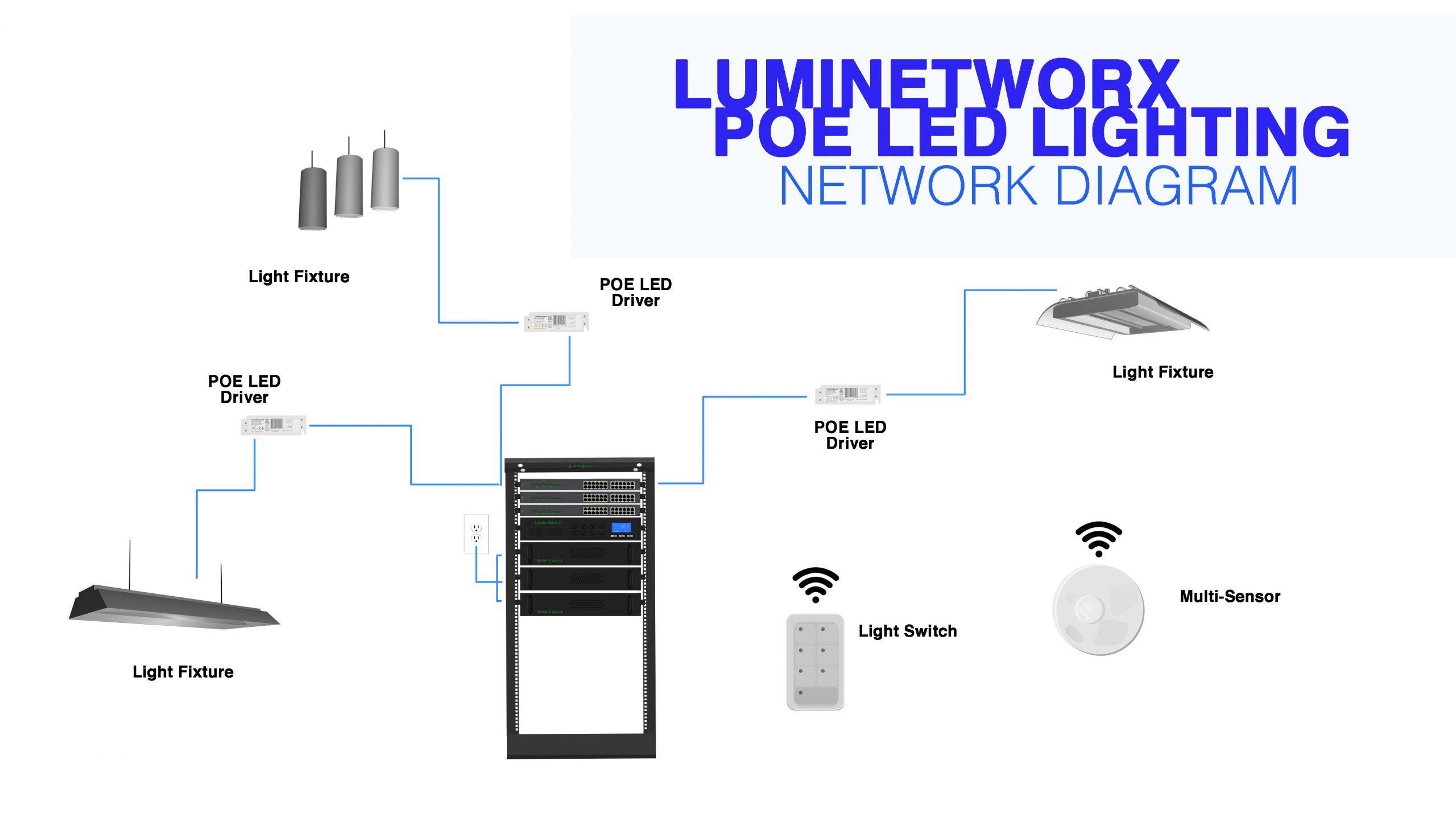What is PoE Lighting?
PoE refers to the ability to provide low-voltage (less than 100W), direct current (DC) power to

network devices. Via the same twisted-pair copper Ethernet cables that are used to transmit data. This eliminates the need for a separate AC power source and allows for more flexible placement options, without concern for proximity to a power outlet.
PoE is a low-cost, reliable, and flexible approach to powering smart devices in a network. It is crucial to enabling smart buildings such as lighting, window shades, sensors, HVAC controllers, cameras, and security systems.
What are the benefits of PoE lighting?
Using PoE to power LED lighting has many benefits over both traditional lighting options (incandescent, fluorescent and CFL, and halogen) and newer AC-powered LED options.
Using LED lighting alone can offer a dramatic reduction in energy required per lumen compared to incandescent and halogen equivalents. But using Luminetworx™ PoE to power and connect lighting has several significant advantages. It can:
- Reduce up-front construction costs by 50% and time to completion by 70% when used for cabling, installation, and configuration. There is also a dramatic reduction in carbon footprint, since no conduit or high-voltage copper wiring need to be installed.
- Lower capital expenditures, labor, and materials costs related to construction and maintenance.
- Allow for greater flexibility in design and placement.
- Enable the optimization of energy consumption by using the building’s network as a sensor and interconnecting devices. This saves money and reduces carbon footprint.
- Require less energy, runs cooler, and be a smaller form factor.
- Using Luminetworx (UPOE+) switch to power, devices. monitor, and control LED lighting, IoT devices, through a decentralized and automated environmental control system.
- Improve lighting through automation. Personalized environments can attract tenants and increase revenue per square foot.
What exactly is LED lighting?
A light-emitting diode (LED) is a semiconductor device that emits light when an electric current is passed through it in a process called electroluminescence.
The wavelength of the light produced—and hence the color—depends on the type of semiconductors used. White light has been traditionally the only option, but the use of gallium nitride (GaN)-based LEDs has significantly expanded the palette of colors available. It has also enhanced the ability to adjust brightness and change colors in real time, opening many new possibilities and applications.
Different semiconductor materials with different bandgaps produce different colors of light. The precise wavelength/color can be tuned by altering the composition of the light-emitting (active) region.
What are the advantages of LED lighting?
Low-voltage LED lighting can offer a dramatic reduction in energy required per lumen when compared to incandescent, halogen metal halide, and fluorescent equivalents. In fact, LED lighting is 30 percent more efficient than even the most efficient alternative, T8 fluorescent.
How does PoE LED lighting differ from AC-powered LED lighting?
There are several key differences between Luminetworx PoE lighting and AC-powered LED lighting.
LED lights need DC power to operate, so AC-powered LED fixtures need a transformer to convert their power source to DC. This can result in a 20 percent loss in power. In addition, the transformer itself can be bulky, and it emits heat because of the conversion.
AC power also requires heavier gauge wire, a conduit, and an electrician to install. With PoE, common Ethernet cabling is used. And because of the low power, it can be safely installed without an electrician. This reduces installation costs, speeds time to completion, and allows for more flexible fixture placement.
PoE lighting can be readily paired with sensors, shades, and HVAC controllers without requiring a separate data cable. ( lighting control system / B.A.S required)
What is a smart building?
A smart building converges buildingwide systems—such as HVAC, lighting, alarms, and security—into a single, IT-managed network infrastructure. It often uses foundational technology like PoE and a unifying control system (B.A.S) to accomplish this convergence.
What is the role of PoE in a smart building?
PoE has evolved from providing 15W of power across Ethernet cabling to providing 90W. With that evolution, the number and types of devices that can be powered and connected by PoE have grown dramatically. Using PoE to power and interconnect devices has several advantages:
- Greater flexibility for hybrid workplace
- Lower cost to deploy than using AC power
- Lower cost to operate than using AC power
- Greater insight, control, interconnectivity, and automation
In a smart building, PoE can power devices such as lighting, sensors, HVAC system controls, shades, and alarms, as well as USB-C laptops, TV and computer monitors (in the near future) and other devices.
Contact Information
If you would like to learn more about the Luminetworx™ PoE Lighting Solution and or Control system contact.
